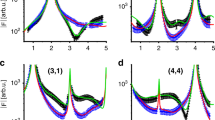Abstract
Magnetite (001), (011), and (111) surfaces were the focus of our study. Magnetite (001) surface has two different terminations, that is, Fetet and 2Feoct4O. Magnetite (011) surface has two different terminations, that is, 2Feoct4O and 2Fetet2Feoct4O. Magnetite (111) surface has six different terminations, that is, Fetet1, Feoct, Fetet2, 3Feoct, 4O1, and 4O2. Comparing surface energies of (001), (011), and (111) surfaces, (001) has the smallest surface energy, and (111) has the largest surface energy except for Feoct termination, which means that (001) surface is the easiest to be cleaved, followed by (011) and (111) surfaces. Comparing adsorption energies of citric acid onto (001), (011), and (111) surfaces, (111) has the largest adsorption energies except for Fetet2 termination, and (001) has the smallest adsorption energies, which means that (111) surface is the most active for citric acid adsorption, followed by (011) and (001) surfaces. PDOS (partial density of states) of citric acid adsorbed onto (001), (011), and (111) surfaces with different terminations shows that 3d orbital of Fe of magnetite surface does not contribute to the adsorption, and 4s orbital of Fe of magnetite surface and 2s and 2p orbitals of O of citric acid contribute to the adsorption.














Similar content being viewed by others
Data availability
All data generated or analyzed during this study are included in this published article.
References
Yin Y, Alivisatos AP (2005) Colloidal nanocrystal synthesis and the organic-inorganic interface. Nature 437:664–670
Kovalenko MV, Bodnarchuk MI, Lechner RT, Hesser G, Schffler F, Heiss W (2007) Fatty acid salts as stabilizers in size- and shape-controlled nanocrystal synthesis: the case of inverse spinel iron oxide. J Am Chem Soc 129:6352–6353
Basavegowda N, Magar KBS, Mishra K, Lee YR (2014) Green fabrication of ferromagnetic Fe3O4 nanoparticles and their novel catalytic applications for the synthesis of biologically interesting benzoxazinone and benzthioxazinone derivatives. New J Chem 38:5415–5420
Sousa FL, Bustamante R, Millan A, Palacio F, Trindade T, Silva NJO (2013) Magnetically responsive dry fluids. Nanoscale 5:7229–7233
Iida H, Takayanagi K, Nakanishi T, Osaka T (2007) Synthesis of Fe3O4 nanoparticles with various sizes and magnetic properties by controlled hydrolysis. J Colloid Interface Sci 314:274–280
Ashour RM, El-sayed R, Abdel-Magied AF, Abdel-khalek AA, Ali MM, Forsberg K, Uheida A, Muhammed M, Dutta J (2017) Selective separation of rare earth ions from aqueous solution using functionalized magnetite nanoparticles: kinetic and thermodynamic studies. Chem Eng J 327:286–296
Bahadur A, Saeed A, Shoaib M, Iqbal S, Bashir MI, Waqas M, Hussain MN, Abbas N (2017) Ecofriendly synthesis of magnetite (Fe3O4) nanoparticles with tunable size: dielectric, magnetic, thermal and optical studies. Mater Chem Phys 198:229–235
Xing Y, Jin YY, Si JC, Peng ML, Wang XF, Chen C, Cui YL (2015) Controllable synthesis and characterization of Fe3O4/Au composite nanoparticles. J Magnetism Magnetic Mater 380:150–156
Kirkpatrick S, Gelatt CD, Vecchi MP (1983) Optimization by simulated annealing. Science 220:671–680
Gale JD, Rohl AL (2003) The general utility lattice program (GULP). Mol Simulation 29:291–341
Mayo SL, Olafson BD, and Goddard WA. Dreiding: a generic forcefield. J Phys Chem, 94:8897–8909, 1990.
Rappe AK, Goddard WA (1991). J Phys Chem 95:3358
Soler JM, Artacho E, Gale JD, Garcia A, Junquera J, Ordejon P, Sanchez-Portal D (2002) The siesta method for ab initio order-N materials simulation. J Phys: Condens Matter 14:2745
Troullier N, Martins JL (1991) Efficient pseudopotentials for plane-wave calculations. Phys Rev B 43:1993–2006
Xue P, Zhaoming F, Chu X (2014) Yanxing Zhang, and ZongXian Yang. Appl Surface Sci 317:752–759
Yu X, Tian X, Wang S (2014). Surface Sci 628:141–147
Perdew JP, Burke K, Ernzerhof M (1996). Phys Rev Lett 77:3865
Haavik C, Stlen S, Fjellvg H, Hanfland M, Husermann D (2000) Equation of state of magnetite and its high-pressure modification: thermodynamics of the Fe-O system at high pressure. Am Mineral 85:514–523
Acknowledgements
The simulation has been carried out on the HP Blade System c7000 (HP BL460c) that is owned and managed by Faculty of Materials Science, Kim Il Sung University.
Code availability
All the calculations were performed by using siesta-4.1-b3 package.
Author information
Authors and Affiliations
Contributions
The first draft of the manuscript was written by Mun-Hyok Ri, and all authors commented on previous versions of the manuscript.
Corresponding author
Ethics declarations
Conflict of interest
The authors declare no competing interests.
Additional information
Publisher’s note
Springer Nature remains neutral with regard to jurisdictional claims in published maps and institutional affiliations.
Rights and permissions
About this article
Cite this article
Ri, MH., Ri, US., Kim, YN. et al. Adsorption characteristics of citric acid on Fe3O4 (001), (011), and (111) surfaces. J Mol Model 27, 332 (2021). https://doi.org/10.1007/s00894-021-04950-7
Received:
Accepted:
Published:
DOI: https://doi.org/10.1007/s00894-021-04950-7




